| Article ID | Journal | Published Year | Pages | File Type |
|---|---|---|---|---|
| 1784257 | Infrared Physics & Technology | 2014 | 7 Pages |
•This is the first study on rotational thermography – a complete breast imaging technique.•Temperature reduction of 2–3° does not provide effective cold challenge.•Texture features carry thermal signatures of abnormalities better than first order statistical features in breast thermograms.•Abnormal breast quadrants have been located automatically.•Malignant condition has been detected accurately by correlating with ultrasound findings.
Breast cancer is a major cause of mortality in young women in the developing countries. Early diagnosis is the key to improve survival rate in cancer patients. Breast thermography is a diagnostic procedure that non-invasively images the infrared emissions from breast surface to aid in the early detection of breast cancer. Due to limitations in imaging protocol, abnormality detection by conventional breast thermography, is often a challenging task. Rotational thermography is a novel technique developed in order to overcome the limitations of conventional breast thermography. This paper evaluates this technique’s potential for automatic detection of breast abnormality, from the perspective of cold challenge. Texture features are extracted in the spatial domain, from rotational thermogram series, prior to and post the application of cold challenge. These features are fed to a support vector machine for automatic classification of normal and malignant breasts, resulting in a classification accuracy of 83.3%. Feature reduction has been performed by principal component analysis. As a novel attempt, the ability of this technique to locate the abnormality has been studied. The results of the study indicate that rotational thermography holds great potential as a screening tool for breast cancer detection.
